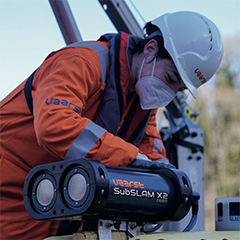Vaarst, the new technology spin-off company from Rovco launched March 2021, with the vision to bring artificial intelligence, machine learning and autonomy to all offshore robotics. Enabling the integration of their technology into all robotic vehicles, both new and as a retrofit solution to existing ROVs.
A technology company borne from a services business
Rovco, out of which Vaarst was born, has operated as a service provider to the offshore sector since 2016, supplying survey and asset integrity services across the offshore lifecycle. But it is Vaarst who has provided the technology that has sat behind Rovco’s innovation-led services. Indeed, Rovco has operated as the testing ground for Vaarst, enabling the technology to be refined and established in the real-world scenario. It has also enabled the naturally cautious energy sector to see the huge benefits that Vaarst technology can bring.
Vaarst technology was created to transform offshore data collection in the survey and O&M domain, where processes and systems are ripe for modernisation. At present, offshore data-gathering demands the deployment of sizeable vessels, that create remarkably high levels of environmental pollution. Each vessel can produce, depending on the job, up to 275K tonnes of CO2 over its lifetime. And can require up to 60 people working in risky conditions, with each vessel costing £1-10m a month to run.
Vaarst is looking at how to do things differently. They started their investigations with educational establishments across the US and Europe, into new methods of data collection in aerial drone technologies. This led them to explore the ExoMars Rover and the methods employed to evaluate landscapes. There was a clear parallel between the challenge of transferring data from Mars back to Earth, and the problem of sending data from deep underwater back to shore. Most evidently with sending video back over this distance. This took Vaarst down the route of SLAM and using 3D data reconstruction as a compression tool.
SubSLAM X2, an AI-driven intelligent data collection system
Vaarst’s SLAM product, SubSLAM X2, is a data-driven computer vision system that delivers live underwater 3D point cloud reconstructions. The model builds in real-time as the vehicle is navigating around the asset. And because the team are still on the vessel while the information is being collected, they can ensure that all the data needed has been obtained during the dive. So, there’s no need for any expensive rework.
Using relative positioning technology, SubSLAM guarantees that the ROV always knows where it is, eliminating the requirement for additional positioning apparatus or scale bars. Although, they can also switch on the IMU for those infrequent times where the visibility isn’t optimal.
Alongside gathering 3D data, their system also collects 4K video, which can be post-processed for high-resolution photogrammetry. So, the customer receives live 3D data on all their assets while on the job and is then able to concentrate their attention when post-processing on creating high detail photogrammetry models for areas of significant interest.























